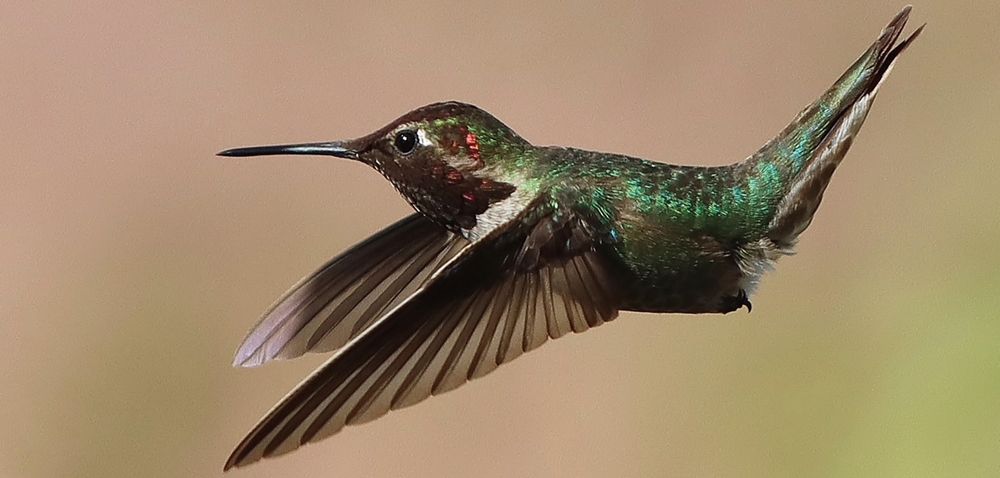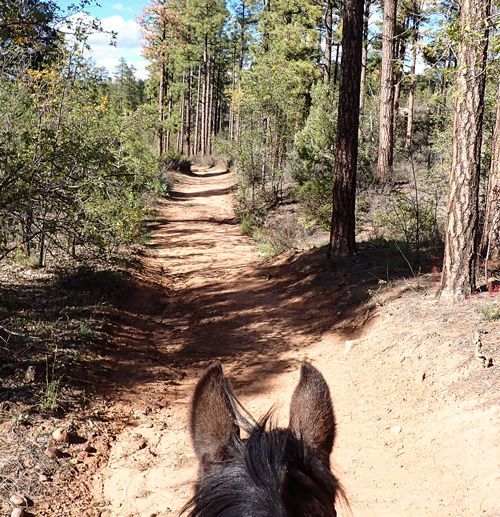The Flutterby birds...

Article by Annemarie Eveland
Photos by D.J. Craig
and Annemarie Eveland
The first time I heard a melodic humming and a tiny bird flew by my head with such blurring speed, it made me feel dizzy. The young girl who was with me called them “flutterby” birds. So, I learned about these fascinating little hummingbirds that have dazzled people for centuries. And then one day, I found that a little hummingbird had built a nest by my front door. It was hanging from the tentacles of my tiny green strings of white Christmas lights. That was three years ago. The well-built tiny nest has lasted through many seasons and weathering outbursts.
I felt that if the mother had built it so well, I could honor her by leaving it for her annual return visit. And she has done so each year faithfully. Next to her perennial nest, I hung a hummingbird feeder and routinely cleaned and refilled it with my homemade sugar water. We have one on the front and back sides of our home, and they are visited frequently. Recently, I was told that it is best to keep feeders clean and replace sugar water every two to three days.
When I discovered this year that she chose again to make this nest to lay her eggs in, and to use as her nursery for her two little babies, I felt so honored. I would slowly open the door, then the screen door, and try to stay behind it as I exited my home so as not to startle her into flying away. It gradually worked, and she trusted our comings and goings as part of our daily routine. The day I saw two heads peeking out of her nest; I knew the time was getting closer to saying goodbye.
As I became more curious about these hummers, I did some research on them. Here are some surprising notes about these beautiful, amazing birds:
• Ruby-throated hummingbird weighs 3 grams — one tenth the weight of a first-class letter.
• Hummingbirds have the largest known relative heart size of all birds — 2.4 percent of their body weight.
• Their egg size is half the size of a jellybean, under half an inch long
• They consume half their weight in sugar each day.
• Their distinguishable long slender bills make them stand out from other species.
• If you compare a man with a hummingbird’s metabolism, he would have to eat 285 pounds of hamburger each day to maintain his weight.
• Rufus hummingbirds have the longest migration route; they fly up to 3,000 miles from their Alaska breeding range to Mexico wintering grounds.
• Ruby-throated hummingbirds fly 500 miles nonstop across the Gulf of Mexico on their migration.
• Hummingbirds do not have a sense of smell. Instead, they locate their food by eyesight.
• A Hummingbird’s heart beats 1,260 times per minute. When it is resting, it takes 250 breaths per minute.
• Hummingbirds can live 12 years, but most live three to five years.
Even in the 16th century, the hummingbirds were described as “size like the end of a thumb, so fast you can’t see their wings move, and have a bill as delicate as a fine needle.”
So, what does the world’s smallest bird do to become the acrobatic champions of our skies? Their daring flights can out-maneuver even birds one hundred times their size. It is the only bird that can fly forward, backward, and upside down! And it’s worth mentioning that it hovers like a helicopter, and because of the bones in its wings, it can turn its wings in any direction. Its iridescent colored feathers are overlapping, and parts of them are covered with thousands of tiny various sized and shaped “bubbles.” These let their feathers change colors as the light hits them from differing angles.
Hummingbirds spend a lot of time eating. They eat more than half their weight in food and drink at least eight times their weight in water. So, a hummingbird may have to visit nectar flowers a thousand times a day. And since they lose body heat fast, they often slow down their metabolism and go into torpor (lasting 8-14 hours) at night if their energy level is low. During the period of torpor, their heartbeat slows down; breathing becomes irregular and at times there is no breathing at all. The next morning, when their body temperature reaches 86 degrees, they can fly again. For its size, the hummingbird uses more energy in a day that any other warm-blooded animal on our planet.
Hummingbird courtship is a blazing acrobatic display by the males. Then females build their nests, sit on the eggs and care for their chicks themselves. Although their nests look tiny and fragile, they surprisingly survive many blustering forces of rain and wind while growing their chicks. At first, the chicks are smaller than a bumblebee, but they grow quickly and often leave their nest in a few weeks. I have found that it is rare to have over two babies. She sits on the nest sheltering her chicks after birth from wind, rain, etc. And I found out that even after they fly out of the nest, she continues to feed them.
One day, I came home and found a chick on our cement walkway. I hesitated for a moment, wondering if I touched the tiny wild bird. Would its mother help it? My mothering instincts kicked in and I picked up the tiny creature and gently put it back in the nest. The other baby was not in the nest. A few days later, the nest was empty, so I surmised that the baby hummingbird flew successfully the second time around.
This year was a surprise to me because I found that we have three hummingbird nests. One in our front entrance, one in upper deck and another in the carport’s steel beam structure. Wow! I guess I should hang up a few more hummingbird feeders, huh?
I have thought about these tiny creatures whose capabilities mesmerize and enchant us with their seemingly impossible abilities and strength. I have enjoyed reading about them, and maybe next season, I will plant a garden using my research that suggests the best nectar flowers they will love. If I don’t get around to that, there are still my hummingbird feeders I can put sugar water in……again.











